No Knead Whole Wheat Sourdough Bread | Small Batch Sourdough
This small, no knead whole wheat sourdough bread is moist on the inside with a crisp delicious crust. I love that it is no-knead, making it perfect for beginner bread bakers. Plus, as a small batch sourdough loaf it works well for gifting, smaller families, or as a snack!
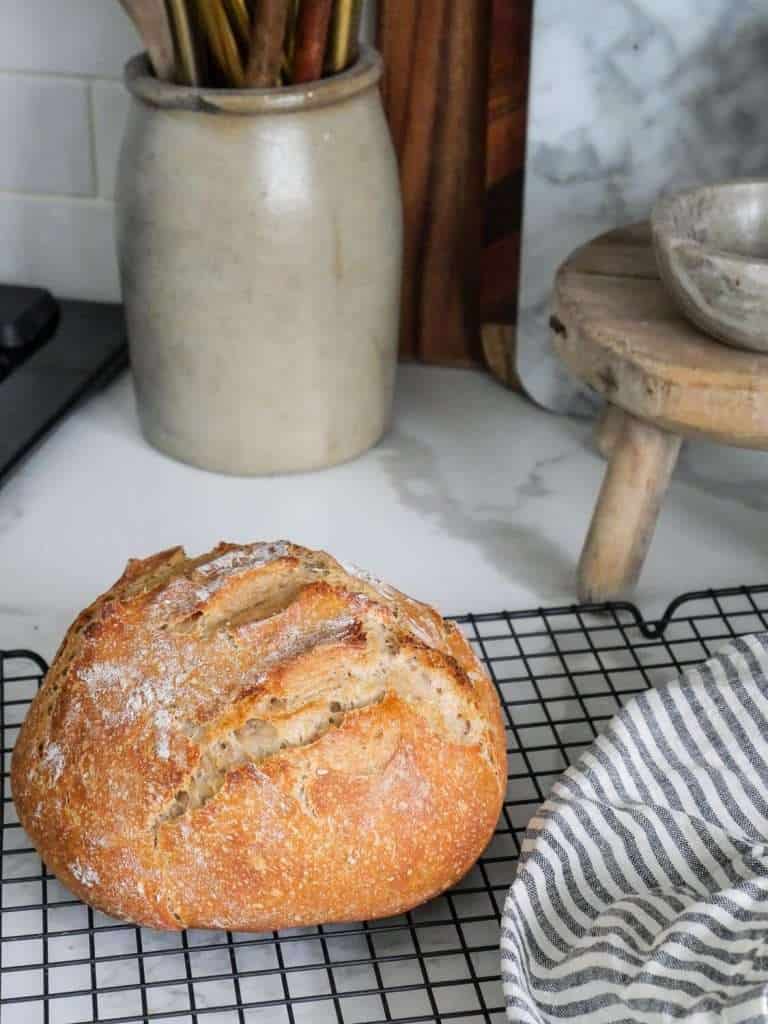
This small loaf sourdough bread recipe makes one small loaf of whole wheat sourdough bread, which will serve 6-8 slices. This recipe is the perfect size to use as a sourdough whole wheat sandwich bread, as well as for toasting with your favorite breakfast foods.
This post may contain affiliate links for your convenience.
If you are a sourdough novice, I highly recommend reading through the entire contents of this article prior to jumping to the recipe. This will help you understand the process and cover some FAQs.
Sourdough Bread Quick Facts
If you are a beginner sourdough baker, the terminology found in sourdough recipes can be confusing. There is a lot to learn when you’re new to sourdough, so here are some quick facts and terminology to get you started.
What Is Sourdough Starter?
Sourdough starter is the ingredient that makes sourdough bread rise. Think of it like an alternative to yeast.
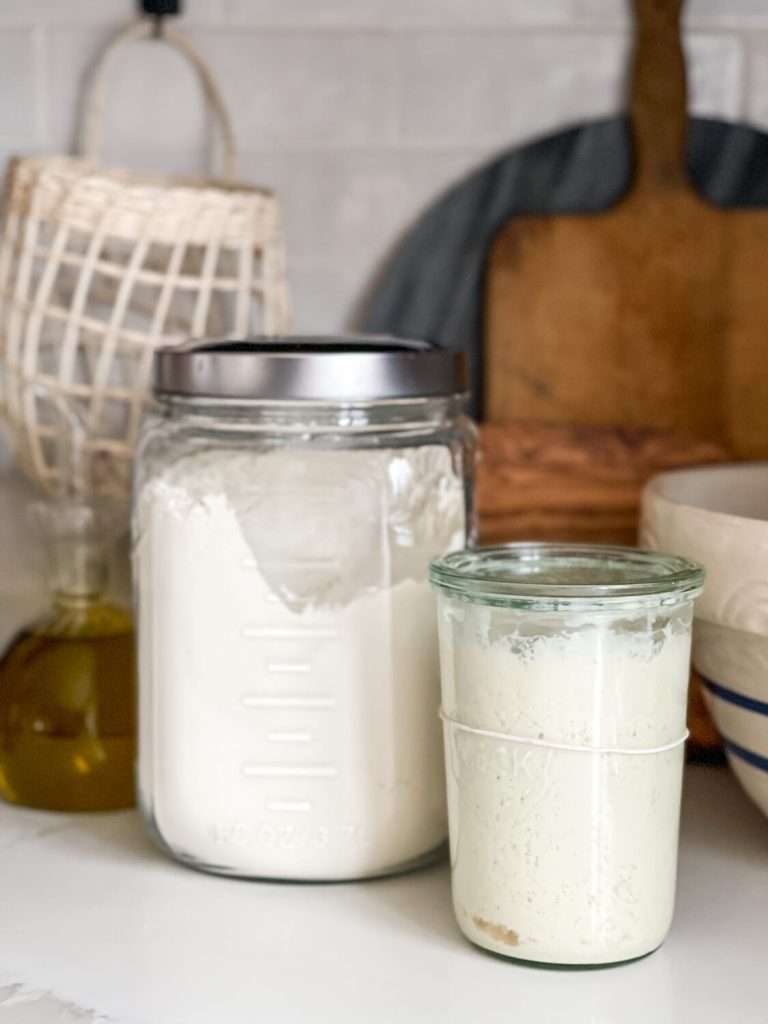
It is a combination of flour and water.
When you create sourdough starter over a period of 7-14 days, you are developing a live fermented culture of the flour and water.
Traditional breads typically use active yeast to make them rise. Sourdough uses sourdough starter!
How Do I Make Sourdough Starter?
You can make sourdough starter right in your own kitchen over the course of a 7-14 day fermentation process.
If you are new to sourdough baking and want to create your own sourdough starter, you will find this article very helpful.
If you do not want to make your own starter, you can purchase it, or ask a friend to gift you some!
Once you have an active and alive sourdough starter, you can keep it forever! You just need to feed it regularly. So if a friend or relative already has starter, they can pass some on to you easily.
Do Smaller Loaves Take Less Time To Bake?
Small batch sourdough bread takes about 15 minutes less time to bake than larger rustic loaves. However, they still pack the same unmistakable sourdough flavor and all the health benefits!
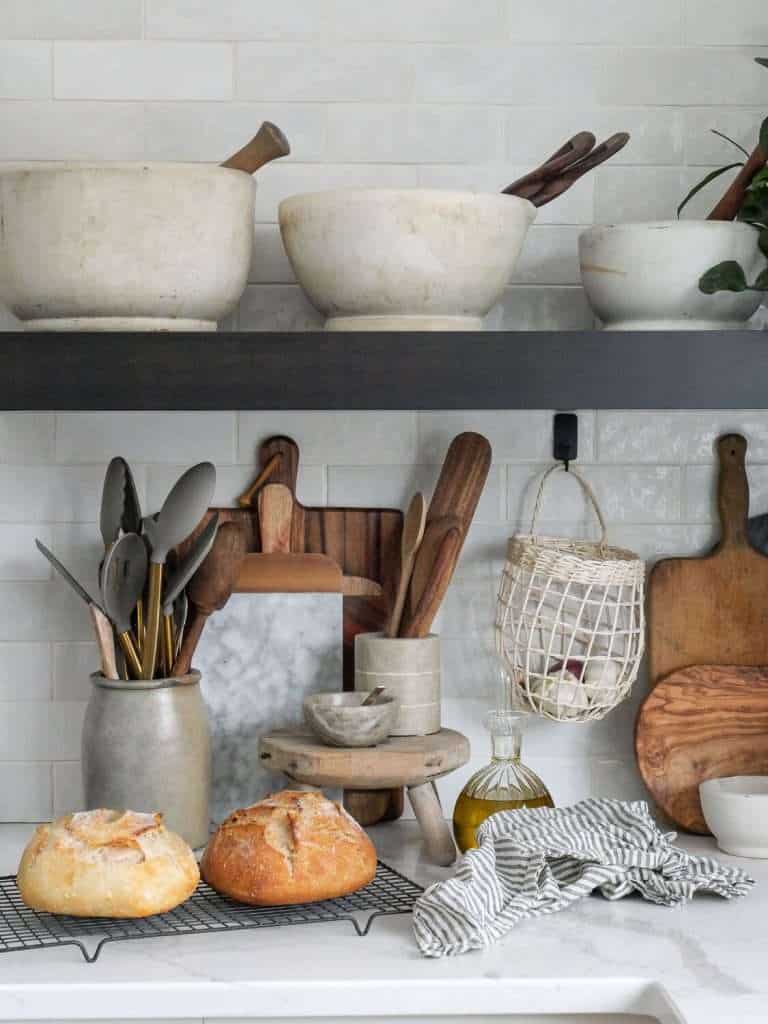
Is Sourdough Healthier Than Bread?
Sourdough has some amazing qualities that yeast breads lack.
It offers more vitamins and nutrients, has less gluten, and is easier to digest than white or wheat bread. Plus, it is made without any sweeteners or oils.
It is an amazing option to consume in place of yeast breads and other baked goods.
Is Whole Wheat Sourdough Better Than White Sourdough?
While all sourdoughs are healthy bread choices, whole wheat does pack more protein, minerals and fiber than white sourdough. Plus, it adds another layer of flavor to make it delicious and nutritious.
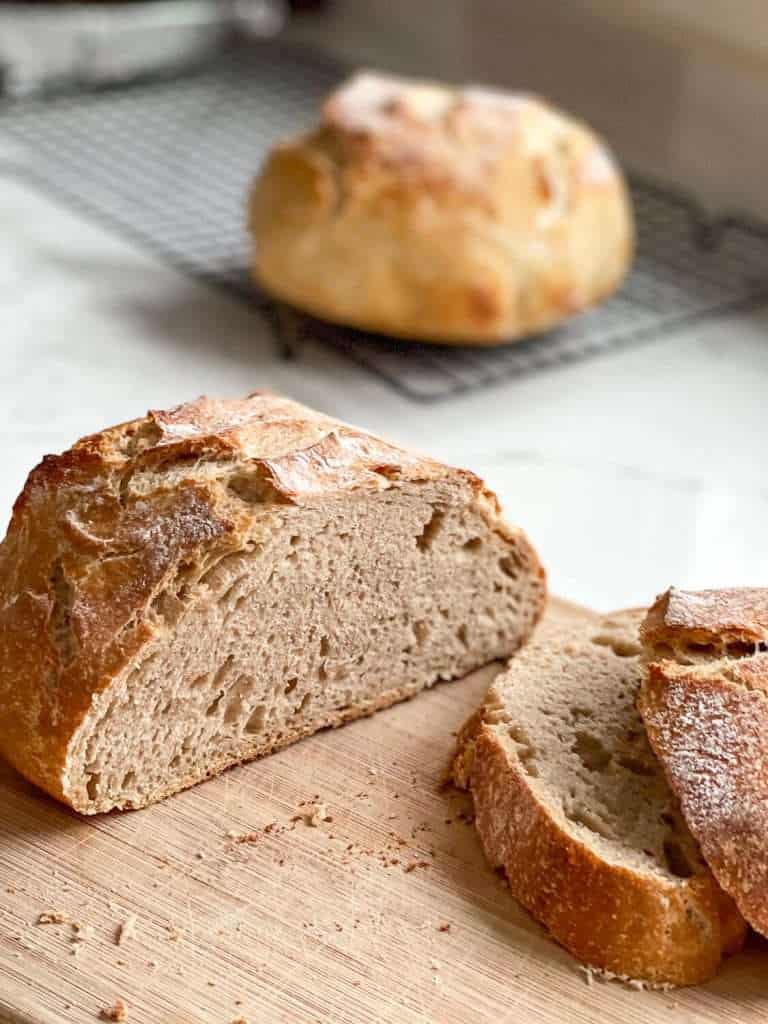
Does Whole Wheat Sourdough Take Longer To Rise?
While my traditional sourdough bread recipe rises overnight for 12-14 hours, whole wheat sourdough typically rises faster. You will want to check your bread right away in the morning to ensure you don’t overproof.

How Does Whole Wheat Flour Affect Sourdough?
Using whole wheat flour instead of all purpose flour will produce a denser loaf of bread. You’ll notice a heavier texture both when stretching the dough and in the final product.
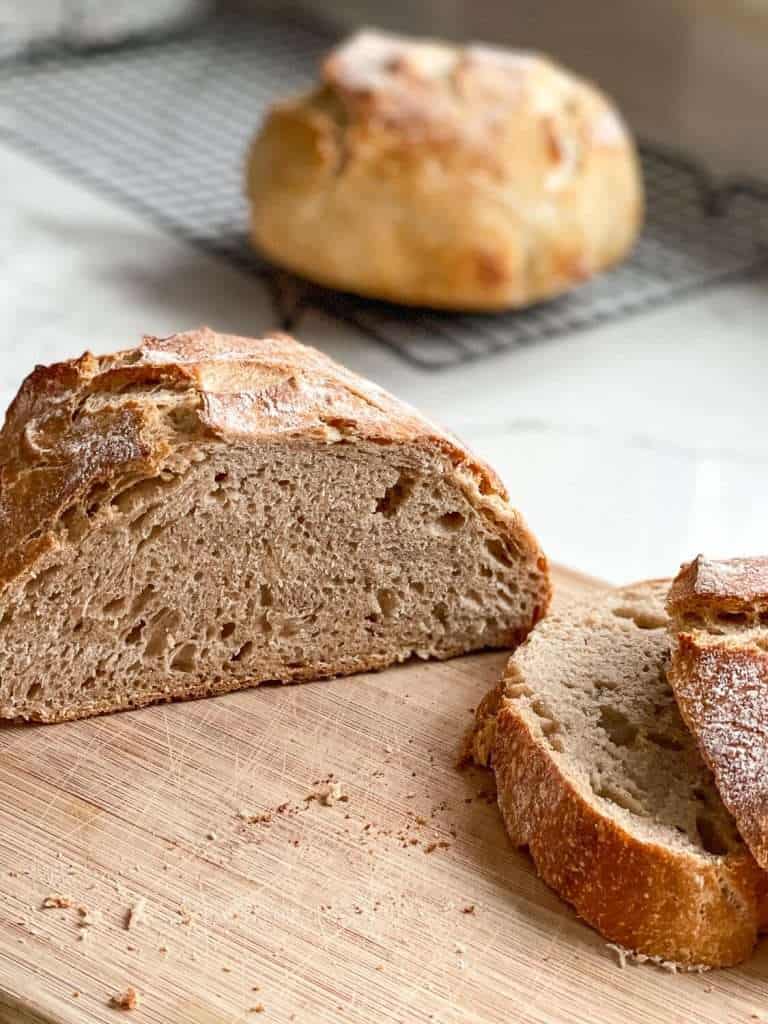
It will also give a more complex flavor because of the bran and extra carbohydrates in the flour.
Small Sourdough Loaf Baker’s Schedule
Baking sourdough is very simple, no matter the size of the loaf that you make. It produces a delicious loaf that is perfect for toast, sandwiches, or a side at dinner.
Basic Tools You’ll Need
- Kitchen Scale
- Glass Mixing Bowls
- Dutch Oven
- Stand Mixer (Optional)
Follow this simple baker’s schedule to take the guess work out of making sourdough bread!

This schedule prepares your bread dough the day before. You will bake the bread the next morning. You can adjust your timeline as needed if you want to bake your bread in the evening.
FEED SOURDOUGH STARTER
7:00am: The day before you will bake your bread, feed your sourdough starter. You must use an active, mature starter for this recipe. Your starter should peak, and then begin to come back down before you mix your bread ingredients.
You do not have to feed your starter with whole wheat flour. Simply use whatever flour you’ve always used.

MIX BREAD INGREDIENTS
7:00pm: The night before you bake your bread, 8-12 hours after feeding your starter, mix all ingredients together.
7:15pm: Do your first set of stretch and folds to help produce gluten and structure to your loaf. (See full recipe for details.)
7:30pm: Do you second set of stretch and folds.
7:45pm: Do a third set of stretch and folds, then let rise overnight in a bowl. Cover your bowl with a damp towel and place in a warm room, away from drafts or cold walls.
SHAPE & RIPEN
6:00-7:00am: Check your dough when you wake up to see how it has progressed. If you live in a warm climate, your dough will likely be ready sooner than those who live in a cold climate.
Your dough should be almost double in size. Do the poke test to see if it has proofed properly. Poke a floured finger into the dough. It should be soft and spring back.
You may notice that the dough is denser than white sourdough. That is fine, as long as it has increased in volume and has a springy surface.
Once ready, shape your dough with a series of stretch and folds. (See full recipe for details.)
Place shaped dough in a parchment lined bowl and let rest uncovered in the refrigerator 1 hour. (The parchment allows for easy transport to the dutch oven later but is not required for baking.)
Preheat oven during that hour with your dutch oven inside. Your oven must be hot.
BAKE
One Hour After Shaping: Remove the dough from the refrigerator. Carefully take your dutch oven out of the oven and place the dough inside. Score the dough as desired, cover, and bake in pre-heated oven.
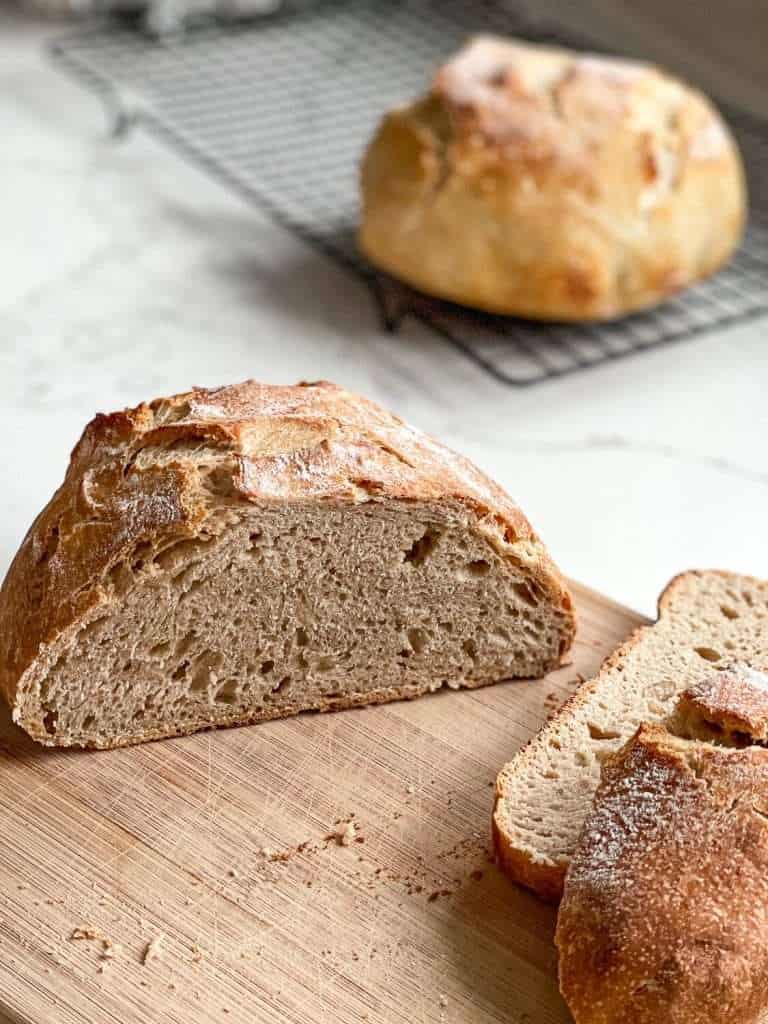
Let cool before slicing.
Full No Knead Whole Wheat Sourdough Rread Recipe Details
Now that you have the baker’s schedule in mind, let’s talk details!
Baking bread is more an experience than simply following a recipe. The temperature of your home, water temp, type of flour you use, and stage of your sourdough starter can all impact your final results.
If you’re an experienced bread maker, then you’ll know there are a million variations that are possible for a simple sourdough loaf. But I’m here to make this as simple as possible for my novices!
As you make more loaves, study the process, and get familiar with what to look for, you can easily branch out into using a variety of flours, adjusting hydration, and adding things like seeds and herbs.
No Knead Whole Wheat Sourdough Bread Ingredients
FEED SOURDOUGH STARTER
As stated in the baker’s schedule above, you will want to feed your sourdough starter in the morning. Let it rise and fall (may take 6-10 hours) before incorporating into bread mixture.
STEP 1: MIX FLOUR & SALT
First, place a large mixing bowl onto your kitchen scale and zero it out.
Then, spoon bread flour and whole wheat flour into the bowl according to their measurements.
Next, add 8g fine sea salt. You can alternatively use kosher salt if you don’t have sea salt on hand.
Mix dry ingredients together.
STEP 2: MIX WATER & SOURDOUGH STARTER
In a separate smaller bowl, add 220 grams of warm water. Then, mix in 70 grams of active sourdough starter. Stir together until the starter is dissolved and the water looks cloudy.
STEP 3: MIX WET & DRY INGREDIENTS
Next, take your dry ingredients and slowly incorporate the wet ingredients with a spatula or wood spoon handle. Mix thoroughly until no flour is left.
This will produce a shaggy dough that is fairly tough. If you have issues fully mixing the flour, add 1 tablespoon of warm water and stir some more. The dough will be sticky, but should not be runny.
Cover the bowl with a towel or plastic wrap and let rest 30 minutes. The dough will loosen up as it rests.
STEP 4: STRETCH & FOLDS
After the dough has had some time to rest, do three to four sets of stretch and folds 15-20 minutes apart. You will do these right in the bowl, no need to place on a floured surface.
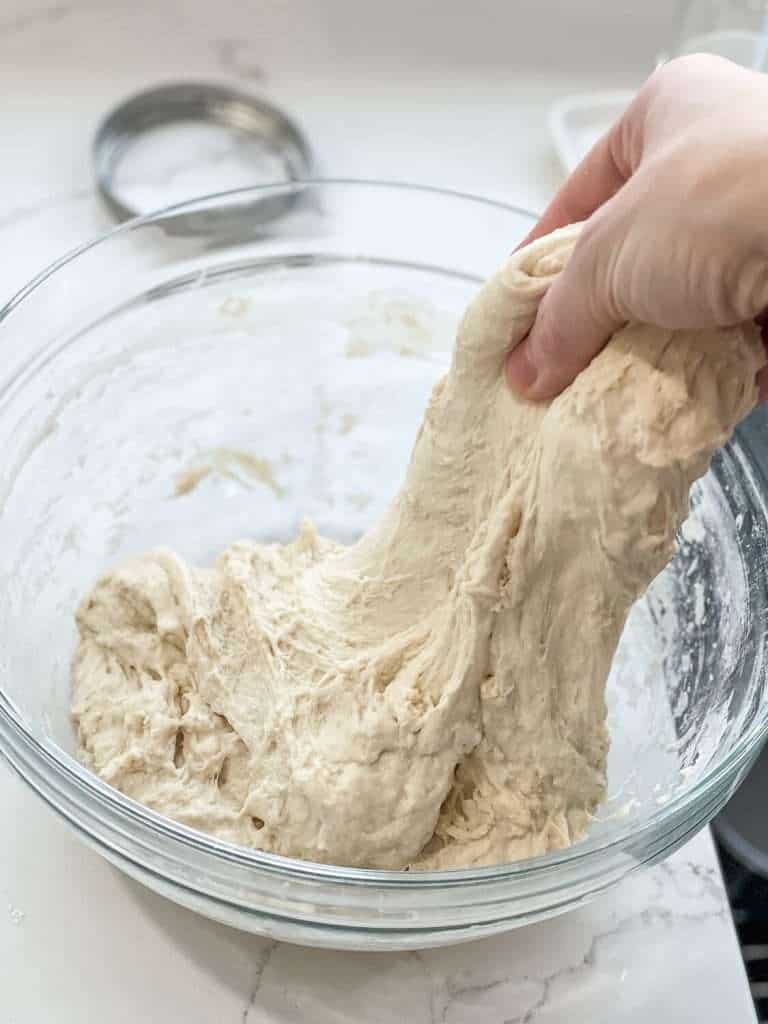
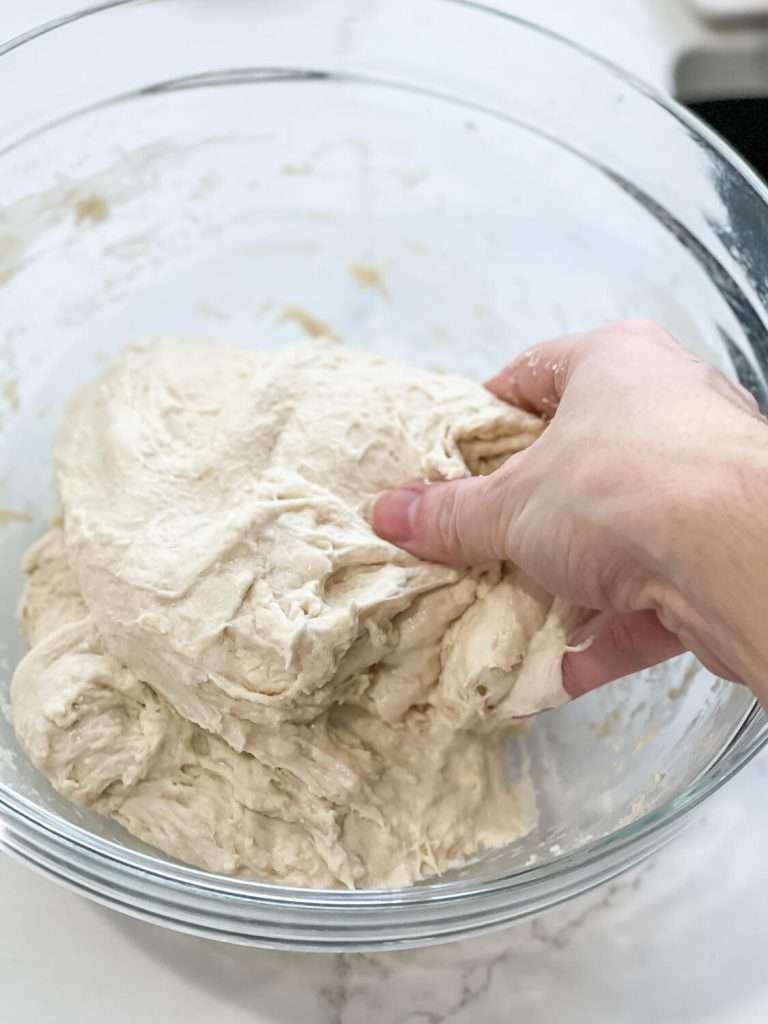

For this set of stretches, think of your dough as a round ball segmented into fourths. Wet one hand, take ahold of 1/4 of the dough and pull it straight up, then fold it over on top of the rest of the dough.
Turn your bowl slightly, then take the next 1/4 and do the same. Repeat this process around the dough ball until all four segments have been stretched up and folded back down. Do this again one more time for a total of 8 stretch and folds.
Wait 15-20 minutes to let the dough rest.
Repeat another set of only 4 stretch and folds.
Wait 15-20 minutes. Repeat another set of 4 stretch and folds if needed.
This process helps strengthen the gluten in the bread.
Cover the bowl with a wet towel and let sit to proof (rise) in a warm place overnight. If you live in a cold climate, make sure you place the dough in your warmest room, away from drafts or exterior walls.
STEP 5: FINAL STRETCH & SHAPE
The next morning, check your dough first thing.
Your dough should be almost double in size and springy. Do the poke test to see if it has proofed properly. Poke a floured finger into the dough. It should be soft and spring back.

If it is hard, it needs more time to proof. You can try placing it in the oven with the light on (but not the heat) for an additional hour. Check again.
Once the dough is ready, you will do your final sets of stretch and folds.
(Watch this quick tutorial to see both methods of stretch and folds needed for this recipe.)
Wet both hands, place them on either side of the dough and scoop it up in the middle. Let the dough hang down on both sides a foot in the air. Let it stretch down a few seconds, then place it back in the bowl, folding over itself.
Wait a minute, turn the bowl, and repeat this process.
Wait 15-20 minutes and repeat a second set of stretch and folds in the same manner. If your dough is runny, you will want to repeat this process again a third time.
Do your third and final set of stretch and folds, then place the dough ball directly into a clean tall sided bowl lined with parchment paper.
STEP 6: RIPEN DOUGH IN REFRIGERATOR
Place your bowl with the sourdough dough into the fridge, uncovered.
Pre-heat your oven to 450 degrees Fahrenheit. Place a dutch oven in the oven as it preheats. Time for one hour.
After the hour is up, your dough will have had time to firm up in the fridge, and your oven and dutch oven will be nice and hot.
STEP 7: BAKE AND COOL
The final step is to bake your small loaf of no knead whole wheat sourdough bread! If you wish, you can score the top for appearance sake. It is fairly easy to make beautiful designs. Otherwise, simply score one side where you want the dough to bloom for a more rustic loaf.

Bake at 450 for 18 minutes, covered. Then, lower the heat to 425, remove the lid, and bake 15-20 more minutes. Your bread should read 205 degrees when taken with a thermometer.
Your oven may vary, so make sure you aren’t over baking around the 25 minute mark from the start of your bake time.
Let your bread cool in the dutch oven for 10 minutes, then remove and cool completely on a cooling rack.
Enjoy!
Free Printable Recipe Card
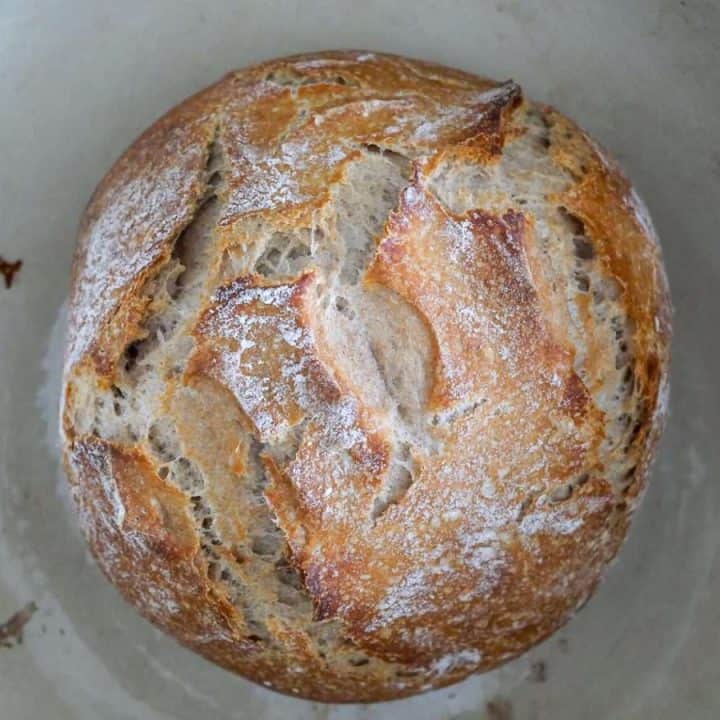
No Knead Whole Wheat Sourdough Bread | Small Batch Sourdough
This no knead whole wheat sourdough bread has delicious complex flavor, a crispy crust and moist middle. Makes 1 small sourdough loaf.
Ingredients
- 200 grams bread flour
- 130 grams whole wheat flour
- 8g fine sea salt
- 70 grams sourdough starter
- 220 grams warm water
Instructions
- If you are new to baking sourdough, it is recommended for you to read my entire blog post with notes prior to starting.
- Morning: As stated in the baker's schedule (see full post), you will want to feed your sourdough starter in the morning. Let it rise and fall (may take 6-10 hours) before incorporating into bread mixture.
- Evening: First, place a large mixing bowl onto your kitchen scale and zero it out. Then, spoon bread flour and whole wheat flour into the bowl.
- Next, add 8g fine sea salt.
- Mix dry ingredients together.
- In a separate smaller bowl, add 220 grams of warm water. Then, mix in 70 grams of active sourdough starter. Stir together until the starter is dissolved and the water looks cloudy.
- Next, take your dry ingredients and slowly incorporate the wet ingredients with a spatula or wood spoon handle. Mix thoroughly until no flour is left. This will produce a shaggy dough that is fairly tough. If you have issues fully mixing the flour, add 1 tablespoon of warm water and stir some more. The dough will be sticky, but should not be runny.
- Cover the bowl with a towel or plastic wrap and let rest 30 minutes. The dough will loosen up as it rests.
- After the dough has had some time to rest, do three to four sets of stretch and folds 15-20 minutes apart.
- Wet one hand, take ahold of 1/4 of the dough and pull it straight up, then fold it over on top of the rest of the dough. Turn your bowl slightly, then take the next 1/4 and do the same. Repeat this process around the dough ball until all four segments have been stretched up and folded back down. Do this again one more time for a total of 8 stretch and folds.
- Wait 15-20 minutes to let the dough rest. Repeat another set of only 4 stretch and folds.
- Wait 15-20 minutes. Repeat another set of 4 stretch and folds if needed.
- Cover the bowl with a wet towel and let sit to proof (rise) in a warm place overnight.
- Next Morning: The next morning, check your dough first thing. Your dough should be almost double in size and be springy. Do the poke test to see if it has proofed properly. Poke a floured finger into the dough. It should be soft and spring back.
- Once the dough is ready, you will do your final sets of stretch and folds.
- Wet both hands, place them on either side of the dough and scoop it up in the middle. Let the dough hang down on both sides a foot in the air. Let it stretch down a few seconds, then place it back in the bowl, folding over itself.
- Wait a minute, turn the bowl, and repeat this process.
- Wait 15-20 minutes and repeat a second set of stretch and folds in the same manner.
- Wait 15-20 minutes. Do your third and final set of stretch and folds, then place dough ball into a clean, parchment lined bowl.
- Place the bowl with the sourdough dough into the fridge. Pre-heat your oven to 450 degrees Fahrenheit and place an empty dutch ovens into the oven as it preheats. Time for one hour.
- Remove bowl from fridge. Place dough into the preheated dutch oven, score as desired, and cover with the lid.
- Bake at 450 degree oven for 18 minutes. Then, remove the lid, lower the heat to 425 and bake 15-20 more minutes. Your bread should read 205 degrees when taken with a thermometer.
- Let your bread cool in the dutch oven for 10 minutes, then remove and cool completely on a cooling rack.
Notes
- Step 14: If your dough is hard, it needs more time to proof. You can try placing it in the oven with the light on (but not the heat) for an additional hour. Check again.
- Your oven may vary, so make sure you aren't over baking around the 25 minute mark from the start of your bake time.
- If your bread didn't rise properly, your starter may not have been active enough. Or, sometimes people use hot water instead of warm, which can kill your starter. Aim for water around 75-80 degrees.
- Sourdough Novices: If you don't have success the first time, try try again! Repeat the same recipe so you aren't changing too many variables. This will give you a chance to learn from the process to see what you might need to change next time.
Nutrition Information:
Yield: 6 Serving Size: 1 sliceAmount Per Serving: Calories: 220
How to Make Sourdough In A Loaf Pan
No dutch oven? You can easily make sourdough bread in a loaf pan with a few minor adjustments. Check out this full recipe for details.
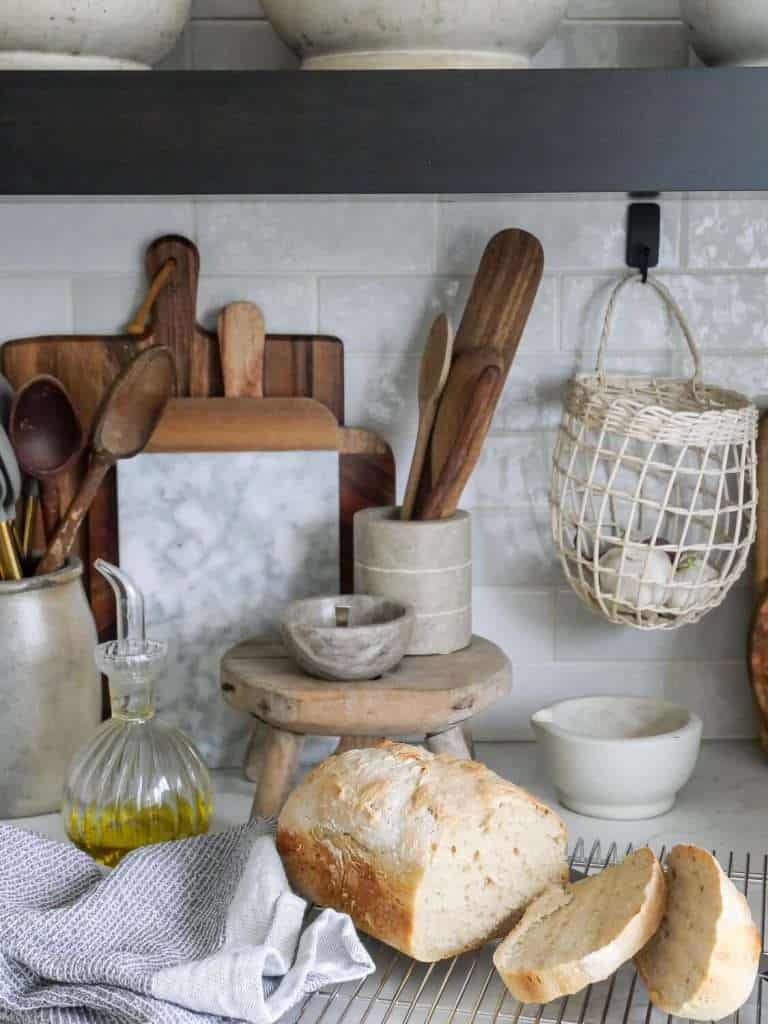
How to Make White Sourdough Artisan Bread
This no knead whole wheat sourdough bread is a delicious option to make anytime. However, if you’re looking for white sourdough, check out this artisan bread recipe that makes two small loaves at once.
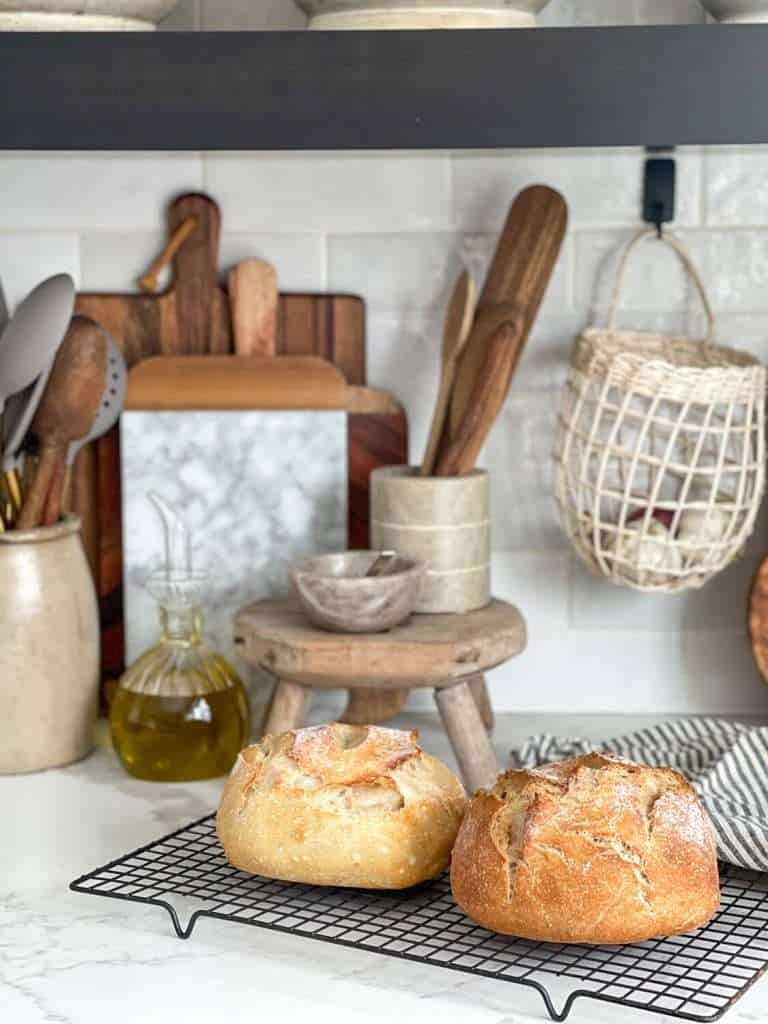
Complete The Meal
I hope you love this no knead whole wheat sourdough bread! I have this recipe on repeat weekly at our home and I hope it becomes a staple in yours as well.

Make sure to save or Pin it for later!
If you’re looking for more quick and healthy recipes, check out these next to complete the meal!
Or, if you’re looking for a hearty soup to go with your sourdough, try one of these recipes.
You can also visit my recipe archives here.
Thanks for stopping by the blog today!
Make sure to subscribe to get my Grace Notes directly to your inbox and to access all my insider perks. You can also follow along daily on Instagram and weekly on YouTube!
~Sarah

Can the recipe be doubled? Thx
Yes, it can! However, it will then produce multiple loaves. If you want one larger loaf try this recipe: https://graceinmyspace.com/easiest-rustic-sourdough-artisan-loaf/
Question: can I leave my dough in the fridge longer than an hour for cold proof? What will happen? Will it over proof? If so, how long is too long in the fridge?
Yes, you can! It will continue to ferment and bring even more sourdough flavor. I wouldn’t do more than 12 hours though as it will overproof and fall flat.
It must be said that the bread taste of each region is very different, it is completely different from what I think when going to California is really different.
I find it a little disingenuous that you are calling it whole wheat bread, when less than half of the flour is actually whole wheat.
Hi Therese, It isn’t titled 100% whole wheat bread. You’ll notice many wheat bread recipes from many bakers include more than simply wheat flour. The reason for that is because using only whole wheat flour produces a very dense, heavy bread that is fairly flat compared to breads with the addition of other flours. If you’d like a 100% wheat bread, I’d recommend checking out Farmhouse On Boone who has a great variety of 100% wheat sourdough recipes.